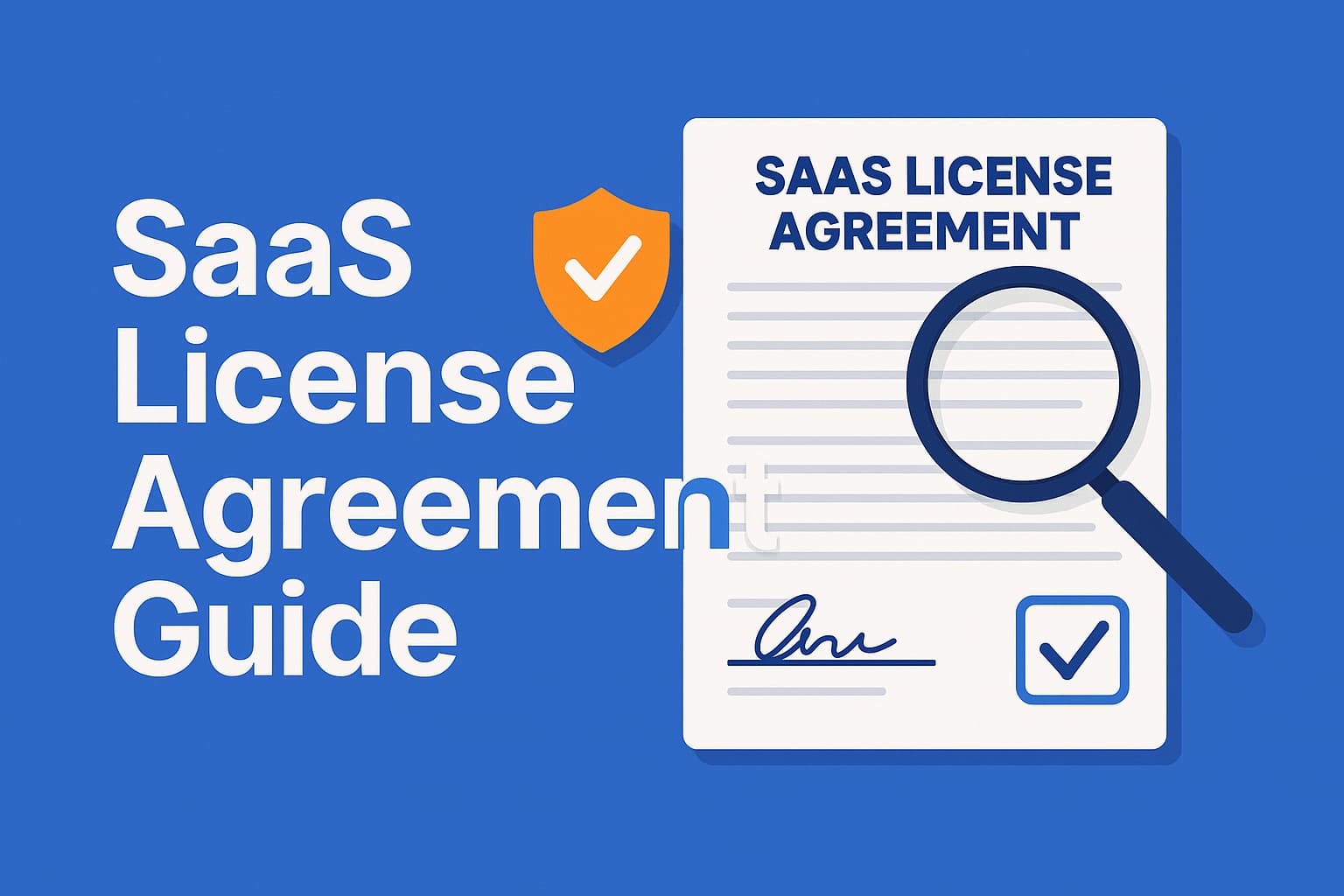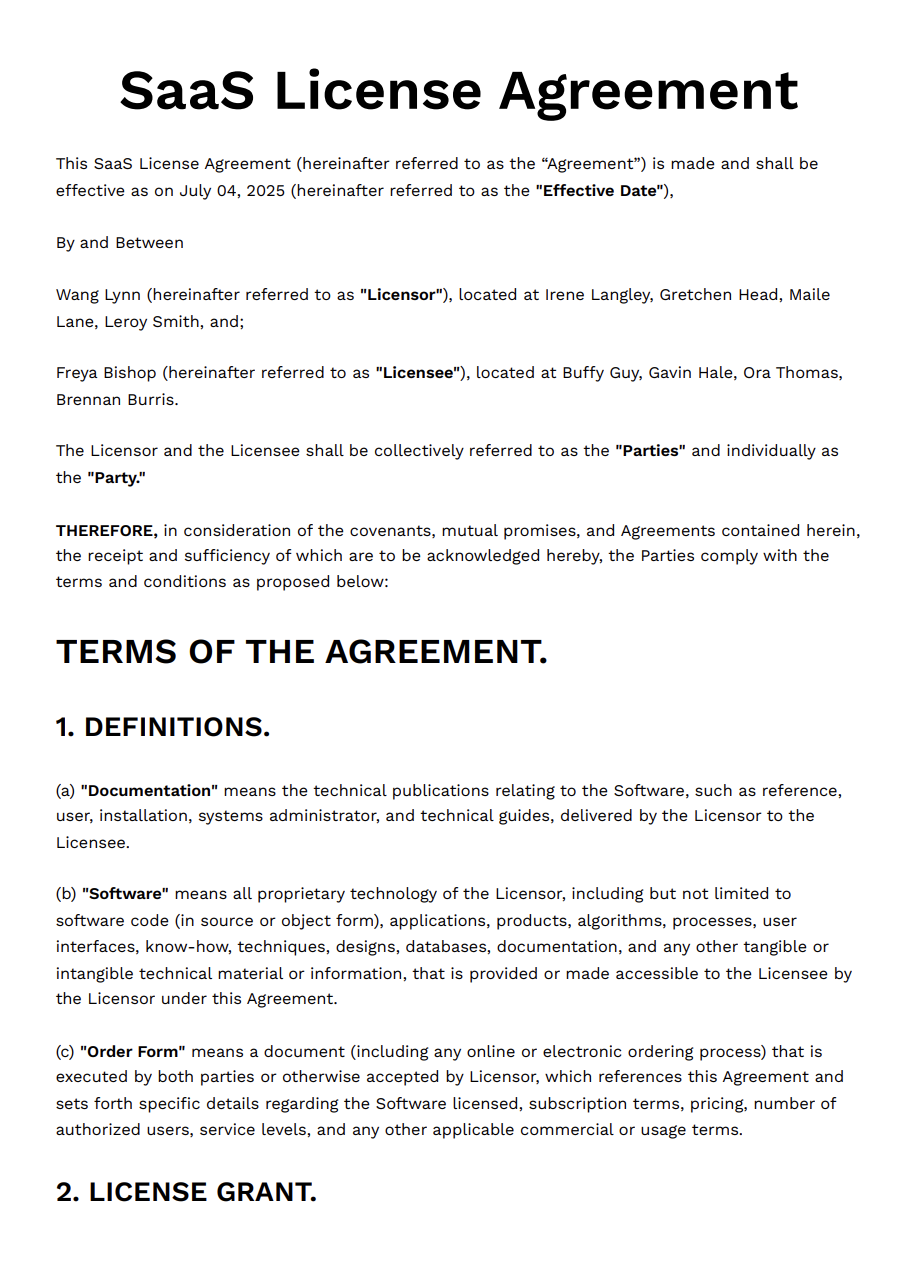SaaS license agreement Guide: Key clauses, mistakes, tips and samples

Table of Contents
- Introduction
- Key Clauses in SaaS License Agreement
- How to Customize a SaaS License Agreement
- Common Mistakes to Avoid
- Tips for SaaS Providers When Negotiating
- Sample Language: SaaS License Clause Examples
- Conclusion
Introduction
A SaaS license agreement is a contract between a software provider and a customer. It allows the customer to use the provider’s cloud-based software. Unlike old-style licenses, this one gives access, not ownership.
SaaS License VS Traditional Software License
In traditional licenses, users buy a copy of the software and install it on their own machines.
In a SaaS license, the software stays on the provider’s servers. Customers log in and use it through the internet.
They never own the software, they just have the right to use it under certain rules.
Why It Matters for Both Licensee and Licensor?
This agreement protects both sides. It makes sure the licensee knows:
- What they can do with the software
- What kind of support they’ll get
- How their data will be used
It also protects the licensor by limiting risk, securing payment, and keeping control of the software.
Key Clauses in SaaS License Agreement
A strong SaaS license agreement should clearly define the rules, rights, and responsibilities for both the licensee and the licensor.
Below are the most important clauses to include, along with explanations of what they mean and why they matter.
License Grant
This clause explains what permission is being given to the customer. It usually states that the provider allows the customer to access and use the software under specific conditions. It also outlines the type of license—whether it is non-exclusive, non-transferable, or limited in time.
For example:
Provider hereby grants Licensee a limited, non-exclusive license to access and use the software during the term of this agreement, solely for internal business purposes.
This clause sets the foundation for the legal use of the software.
Restrictions
Restrictions describe what the customer is not allowed to do with the software. These may include:
- Reverse engineering or copying the code
- Sharing login credentials
- Using the service for illegal or harmful purposes
This protects the provider’s intellectual property and ensures fair use.
Term and Termination
This section tells when the agreement begins and ends. It also outlines how either side can cancel the agreement. A standard SaaS license agreement may be:
- Month-to-month
- Annual with automatic renewal
- Fixed-term with a set expiration date
The termination terms should include what happens to data after the contract ends and how final payments or refunds are handled.
Fees and Payment Terms
Here, the pricing model is explained in detail. This includes:
- How much the Licensee pays and how often
- What happens if payment is late
- Whether taxes, transaction fees, or price changes apply
This clause also defines consequences for missed payments, such as service suspension or contract cancellation.
You can also describe the “How much the Licensee pays and how often” in an Order Form
Intellectual Property
This clause explains who owns what. The licensor usually owns the software, its code, and all updates.
The licensee owns their own data and any content they input into the system.
Sometimes, a licensee may create custom features or integrations. The agreement should clarify if those additions belong to the licensee or are shared.
Limitation of Liability
This section limits the financial risk for both parties. For example, it may state that:
- Neither party is responsible for indirect or lost-profit damages
- Total liability is capped at the amount paid in the last 12 months
This helps reduce lawsuits and encourages both sides to work together to solve issues.
The clauses above are essential components of a SaaS License Agreement. That said, there are still other important provisions worth considering, see here.
How to Customize a SaaS License Agreement
Every SaaS product is different, and a one-size-fits-all contract may not work for your needs.
Customizing your SaaS license agreement helps align legal terms with how your software is built, sold, and supported.
if your SaaS product allows users to install part of the software on their own systems (like a local agent), you may need to adjust the license to address that extra component. Or, if you have different product tiers, the license may need to reflect the features and limits for each one.
If you serve customers in different countries, your license should:
- Follow local privacy and data protection laws (such as GDPR in Europe or PIPEDA in Canada)
- Be translated if required by local law or customer preference
- Specify which country’s law will govern the agreement and where disputes will be handled
Also, tax rules and payment handling can vary by region, so your billing terms may need to adapt. You may also need to offer terms in different currencies or clarify how currency conversion is handled.
Common Mistakes to Avoid
Creating or using a SaaS license agreement without careful attention can lead to misunderstandings, legal trouble, or customer dissatisfaction.
Below are some of the most common mistakes providers make and how to avoid them.
Using Outdated Software License Templates
Many startups reuse license templates meant for traditional software. These often assume the customer installs and owns a copy of the software. But SaaS is different. Using an old license can leave out critical sections about cloud access, data rights, or service levels.
What to do instead: Use a contract designed specifically for SaaS. Update it as your product, pricing model, and compliance needs change.
You can try our template or builder at SaaS license agreement builder
Tips for SaaS providers when negotiating
Negotiating a SaaS license agreement can be complex, especially with larger or enterprise clients.
Customers may request changes to the agreement. Here are tips to help you stay flexible while protecting your business.
What Enterprise Clients Usually Ask For
Large clients often want:
- Custom SLAs with higher uptime guarantees or faster support
- More control over data, such as location or deletion procedures
- Stronger security terms, especially if they are in regulated industries
- Clear exit terms, including how they can retrieve data when the contract ends
These clients may also request changes to payment terms, renewal terms, or limitations on your liability.
Tip: Prepare a version of your agreement with optional clauses you can offer during negotiations.
How to Stay Flexible Without Risking Your Business
It's important to show flexibility but not at the cost of your product's stability or company’s legal safety.
- Use addendums for negotiated changes instead of rewriting the core contract
- Avoid promising features that don’t exist yet
- Get legal input before accepting changes to data or IP clauses
- Make sure any custom deal is approved by all key teams (legal, support, product)
This keeps your contract manageable and protects your company from accidental overcommitments.
When to Offer Custom Terms or Stick to Standard
Not every customer needs a custom deal. It’s okay to stick with your standard agreement, especially for:
- Small to mid-sized customers
- Self-serve platforms with low-touch sales
- Early-stage SaaS companies with limited legal resources
Offer custom terms only when:
- The deal size justifies the legal effort
- The customer has specific needs that impact their ability to use your product
- There is mutual long-term value in the relationship
Balancing flexibility and consistency helps you grow without slowing down operations.
Sample Language: SaaS License Clause Examples
To help you better understand how a strong SaaS license agreement looks in practice, here are some plain-English examples of common clauses.
Each sample includes an explanation so you can see why the wording matters.
License Grant
The Provider grants the Customer a limited, non-exclusive, non-transferable license to access and use the Service during the Term solely for internal business purposes.
Restrictions
The Customer shall not copy, modify, reverse-engineer, or create derivative works of the Service. The Customer agrees not to use the Service in violation of applicable laws.
Payment Terms
All fees are due within 30 days of invoice. Late payments may result in suspension of service. The Provider may update pricing with 30 days’ written notice.
Intellectual Property
The Provider retains all rights, title, and interest in the Service. The Customer retains ownership of all data entered into the system.
Conclusion
Writing and negotiating a SaaS license agreement can be a big challenge.
But by mastering a few of the important clauses and making sure that the rights of both parties are guaranteed, the negotiation process becomes easy and simple.
